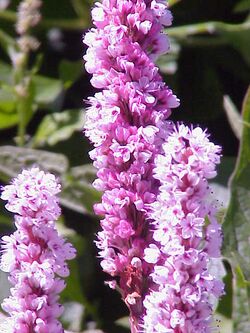Biology:Bistorta affinis
| Bistorta affinis | |
|---|---|

| |
| Scientific classification | |
| Script error: No such module "Taxobox ranks".: | Plantae |
| Script error: No such module "Taxobox ranks".: | Tracheophytes |
| Script error: No such module "Taxobox ranks".: | Angiosperms |
| Script error: No such module "Taxobox ranks".: | Eudicots |
| Script error: No such module "Taxobox ranks".: | Caryophyllales |
| Script error: No such module "Taxobox ranks".: | Polygonaceae |
| Script error: No such module "Taxobox ranks".: | Bistorta |
| Script error: No such module "Taxobox ranks".: | <div style="display:inline" class="script error: no such module "taxobox ranks".">B. affinis |
| Binomial name | |
| Bistorta affinis (D. Don) Greene
| |
| Synonyms[1] | |
| |
Bistorta affinis (synonyms Polygonum affine, Persicaria affinis), the Himalayan bistort,[2] fleece flower, or knotweed, is a species of flowering plant in the family Polygonaceae, native to the Himalayas (Tibet, Nepal, northern India, Pakistan, Kashmir).
Description
Bistorta affinis is a creeping, densely tufted, mat-forming perennial, growing to 25 cm (10 in) tall by 60 cm (24 in) broad. The narrow elliptic leaves are white on the underside because of a waxy coating. Leaves are mostly at the base, 3–8 cm long, with the base narrowed to a short stalk. Leaf margins are entire or very finely toothed. The mid-vein is prominent. Cylindrical spikes of many pale pink or rose-red flowers are borne at the top of short erect stems, from midsummer to autumn. Flower-spikes are 5–7.5 cm (2–3 in) long, with densely crowded flowers. Stamens protrude slightly out of the flowers. Flowering stems are several, 5–25 cm tall, with very few smaller leaves. When the flowers have died, they tend to persist on the plant into winter.[3][4]
Habitat
Bistorta affinis is found in the Himalayas, from Afghanistan to eastern Nepal, at altitudes of 3,000–4,800 m (9,843–15,748 ft).[5]
Cultivation
Bistorta affinis is used ornamentally as groundcover.[6] Under the synonym Persicaria affinis the following cultivars have gained the Royal Horticultural Society's Award of Garden Merit:[7]
References
- ↑ "Bistorta affinis (D.Don) Greene". Plants of the World Online. Royal Botanic Gardens, Kew. https://powo.science.kew.org/taxon/urn:lsid:ipni.org:names:693182-1. Retrieved 2019-03-01.
- ↑ (xls) BSBI List 2007, Botanical Society of Britain and Ireland, https://bsbi.org/download/3542/, retrieved 2014-10-17
- ↑ RHS A-Z encyclopedia of garden plants. United Kingdom: Dorling Kindersley. 2008. p. 1136. ISBN 978-1405332965.
- ↑ Flora of China, Polygonum affine D. Don, 1825. 密穗拳参 mi sui quan shen
- ↑ "Kew Gardens - Plants & fungi - Persicaria affinis". http://www.kew.org/plants-fungi/Persicaria-affinis.htm. Retrieved 25 May 2013.
- ↑ Pink, A. (2004). Gardening for the Million. Project Gutenberg Literary Archive Foundation. https://www.gutenberg.org/ebooks/11892.
- ↑ "AGM Plants - Ornamental". Royal Horticultural Society. July 2017. p. 75. https://www.rhs.org.uk/plants/pdfs/agm-lists/agm-ornamentals.pdf. Retrieved 22 April 2018.
- ↑ "RHS Plant Selector - Persicaria affinis 'Darjeeling Red'". https://www.rhs.org.uk/Plants/77933/Persicaria-affinis-Darjeeling-Red/Details.
- ↑ "RHS Plant Selector - Persicaria affinis 'Donald Lowndes'". https://www.rhs.org.uk/Plants/60308/Persicaria-affinis-Donald-Lowndes/Details.
- ↑ "RHS Plant Selector - Persicaria affinis 'Superba'". https://www.rhs.org.uk/Plants/67494/Persicaria-affinis-Superba/Details.
Wikidata ☰ {{{from}}} entry
 |
